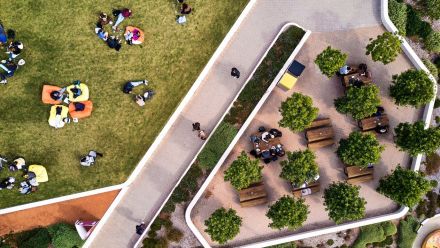Total design
A new book details the legacy of iconic ANU designer Fred Ward, writes TEGAN DOLSTRA.
Entering Derek Wrigley's house is like entering an art gallery. On every spare square of wall is hung a painting, a photograph, a sculpture. But what truly stands out is the furniture.
Wrigley was University Architect and Head of the ANU Design Unit from 1961 to 1977. For five years before that he worked with the late Fred Ward, now recognised as a pioneer in Australian design.
Wrigley and Ward's distinctive pieces of furniture have graced the University for more than half a century. Not only can they be seen on proud display in University House and the Mills Room of the Chancelry, and the offices of deans and pro vice-chancellors, but more understated pieces rest quietly in common rooms and student colleges.
Many of Ward's functional fittings can be spied farther afield. His iconic work is on display in the Reserve Bank, the National Library and the Prime Minister's Residence, to name a few.
Now Wrigley has written a book to catalogue his old friend and colleague's life and career.
"Much of Fred's work was designed for the sort of places that the public don't have ready access to, such as in the Reserve Bank or in various private rooms," says Wrigley. "His elegant furniture is hidden away so there was a great possibility, I felt, that his work was being ignored by history. It needed to be recorded."
[youtube]XZ0ss96mp-o[/youtube]
There is no doubt that many Canberrans didn't value Ward's genius. At the time of his death in 1990, hundreds of his chairs and desks were being sold at heavy discounts or sent to the tip, to be replaced by new 'ergonomic' designs.
"For me - and, I suspect, for many Canberrans - Fred's furniture was just part of the scenery," says Ward's granddaughter, Juliet.
"It didn't seem strange to me that the University was full of his furniture because it was everywhere in my life."
But 24 years after his death, Ward's pieces are now being seen as a significant part of Australian history. New and long-time Ward enthusiasts alike are no doubt delighted with Wrigley's book, Fred Ward: Australian Pioneer Designer 1900-1990.
As you would expect, its elegant pages document Ward's simple pieces in meticulous detail. But it also delves into other aspects of his life, including time spent working on the timber-framed Mosquito bomber plane during World War Two and an early working relationship with Sidney Nolan's wife, Cynthia.
Wrigley also records that Ward spent much of his time on 'social design' projects, such as initiating the Australian Design Council.
It is fitting that, while writing the book, Wrigley sat on a chair designed by Ward for Lord Casey, then Minister for Immigration in the Menzies government.
"I found it entirely by accident in the basement of the Chancelry Annex with a broken leg," Wrigley recalls. "I took it down to maintenance and they fixed it up for me and it became my desk chair. And when I retired it was presented to me.
"It's my favourite piece of all Fred's furniture and it's got a history."
It is typical of Wrigley, a talented furniture designer in his own right, that one of his favourite pieces of furniture is one designed by Ward. The incredibly modest 90-year-old seems unfazed that many of his own designs are "taken for Fred's".
"It's a nice compliment," he says.
"I'm glad I've written the book. It was a hell of a lot of work but I'm very glad I've done it.
"It was almost a family production. My son Ben took most of the photos and my sister Shirley handled all the sales. Gillian, who designed the layout, is a friend of the family and used to work at ANU, and ANU Printing Services did the printing."
Wrigley is hoping to write another book, this time focusing on his own work.
"When I was appointed University Architect in 1961, I was encouraged by Ross Hohnen to further develop 'total design' - the integration of every aspect of the University: its buildings, its landscapes, interiors, graphics, and so on," he says.
"We wanted to relate these aspects of university life so that students could have a well-designed ambience that would sub-consciously impress itself on their memories and their minds; so that they learned from their surroundings as well as from their professors."
It is intriguing to speculate about the discussions and happenings Wrigley and Ward's chairs have themselves absorbed from their surroundings of the past half century.
"I have seen some of Fred's chairs, several decades old, that have been out in the weather on a student college balcony but are still beautiful and totally functional, even if they do need a bit of a clean and the chewing gum removed from under the seat," says Juliet.
"You can't say that about much these days." Here's to another 50 years.
For more photos download the ANU Reporter app.
This article appeared in ANU Reporter magazine Autumn 2014. Subscribe for free now.


